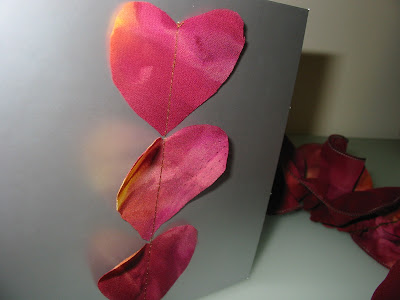My little niece is five years old. She loves ballet and princesses. She is my outlet for all things girl, so how could I resist her request for a tutu ballet bag. This was quite an involved project, which I made up as I went along and took pictures along the way. It is quite a long tutorial so please ask questions if anything is unclear and I would love to see pictures of your creations on my
facebook page.
Here is what I did:
Cut four pieces of pink satin 28x28cm with 3x3cm squares cut out of two adjacent corners. Also cut a piece of pink organza (or tulle) 56x40cm.
For the skirt of the tutu, cut a piece of organza or tulle to 40x25cm, fold lengthways and sew up the short sides with a narrow serged (eg. rolled hem) or zig-zag stitch. Then sew a gathering stitch through the two layers on the remaining side, gather tightly and tie ends to keep gathers in place.
Draw the outline of the tutu bodice on to a piece of fusible interfacing and iron it on to your scrap of pretty fabric. Cut around the outline on the interfacing.
If the fabric is likely to fray, carefully seal the edges with fabric glue or nail polish. This would not be necessary for stretch fabric.
Take one of the four pieces of satin you cut for the bag. You will apply your design on the this piece. Remember the bottom and sides of the satin will fold around to become the bottom and sides of the bag, so leave space around your design for this as well as a bit of space at the top for finishing.
Place the skirt and bodice of the tutu on the satin and pin in place. Pin the lower edge of the bodice over the gathers of the tutu so they are hidden. Stitch in place around the bodice using a straight stitch with matching thread. This should be enough to hold the whole tutu in place.
Take two small and three medium sized ribbon roses (you can buy these or easily make them as shown
here) to embellish the straps and waist of the tutu. These can be glued on (I used a glue gun) or stitched.
When you are happy with your design, you can sew the bag together. If you liked, you could add sparkles or beads to the skirt or surrounding fabric first. I left mine like this.
With right sides together, sew the bottom and sides of the bag. Make sure the tutu is out of the way of the stitching.
Take each inside corner point and pull apart, then stitch as shown.
Repeat with the remaining two pieces of satin to make the lining.
Next we'll make the gathered top part of the bag. You can see this in the photo below of the finished bag.
Using the large piece of organza, fold in half and stitch the two shorter sides together. Fold in half with the seam inside as shown.
Place flat on the table and mark where you would like the gathering ribbon holes. I did mine in the centre between the seam and the side fold.
Open out the circle of organza and make buttonholes where you drew the lines. Use a scrap of interfacing to stabilise the fabric or it will disappear inside the sewing machine - I learned this the hard way! Trim the excess interfacing when buttonholes are done.
Cut the buttonholes, refold the organza in half, then stitch the ribbon casing.
Thread some ribbon through.
Place the lining inside the bag, wrong sides together. Then place the organza ribbon section inside the bag, wrong side to the inside. Stitch all six layers together around the top of the bag.
Next make the handles. Cut two pieces of satin 60x4cm. Sew each into a long tube, right sides together and turn right side out.
Trim each to approximately 50cm. Pin to the bag approx 1 inch in from each side seam. The handles should be just inside the upper seam. Stitch in place.
Make a ruffle by stitching a tube of organza and gathering one edge.
Pull the organza ribbon section up out of the bag. Sew the ruffle along the top hem and sew a ribbon on top to cover the hem and ruffle edge. I did this in one step as shown, but it was fiddly and some of the organza slipped out from under the ribbon, so had to be redone.
And that's it! I hope you've managed to stay with me this far and that you've made a beautiful bag for your little princess.
Meg xxx
















































